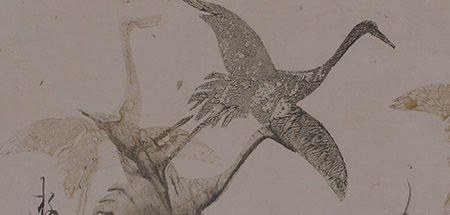Timeline
Today, Tawaraya Sōtatsu (active circa 1600–40) is regarded as one of the most inventive and visually dynamic painters in Japanese history, although we know very little about the man himself—his actual life dates, his family, his teachers. Our knowledge of the artist is based primarily on our knowledge of the output of the Tawaraya studio. In many ways, we are still in the process of discovering Sōtatsu.
circa 1600–40
Sōtatsu heads the Tawaraya shop in Kyoto, which sells fans and decorated cards and paper.
1602
Sōtatsu repairs the 12th-century decorated sutra Heike nōkyō.
Movable metal type is introduced to Japan, prompting Emperor Go Yōzei (1571–1617) and the shogun Tokugawa Ieyasu (1543–1616) to sponsor a number of printing projects.
Merchant Suminokura Soan (1546–1614) starts a printing press that produces literary classics and nō librettos.
Sōtatsu collaborates with calligrapher Hon’ami Kōetsu (1546–1614).
1606
A set of shikishi (poem cards) by Sōtatsu and Kōetsu marks the retirement of Imperial Regent Konoe Nobutada (1565–1614).
1615–24
Sōtatsu, assisted by Tōshichirō, produces Painted Fans Mounted on a Screen, likely commissioned by the imperial court.
1621
Sōtatsu decorates the sliding doors at Yōgen’in Temple.
The artist is given the honorific Dharma Bridge title and from this point signs his work Hokkyō.
circa 1627
Sōtatsu paints Waves at Matsushima.
1630
Sōtatsu copies Life of Saigyō, a set of medieval picture scrolls in the imperial collections.
1631
Sōtatsu creates The Barrier Gate and Channel Buoys for Daigoji temple.
1637
Kōetsu dies and is buried at Koetsuji.
1642
Sōtatsu is presumed to be deceased. The Tawaraya shop remains active and produces several grass-and-flower screens marked with the I’nen seal.
1658
Birth of Ogata Kōrin. He adapts Sōtatsu’s style, which comes to be known as Rinpa.
1716
Kōrin dies.















